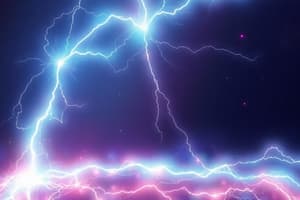Podcast
Questions and Answers
State Ohm's law.
State Ohm's law.
V=IXR, R=V/I, I=V/R
If current goes down, what does resistance do?
If current goes down, what does resistance do?
- It cannot be determined
- Resistance goes up (correct)
- Resistance goes down
- Resistance stays the same
If voltage is constant and resistance goes down, what must current do?
If voltage is constant and resistance goes down, what must current do?
- Current stays the same
- Current goes up (correct)
- Current goes down
- Current fluctuates
What is the definition of a short circuit?
What is the definition of a short circuit?
What would cause current to decrease in a circuit, if voltage remained constant?
What would cause current to decrease in a circuit, if voltage remained constant?
What is a transformer?
What is a transformer?
What are transformers used for?
What are transformers used for?
State the power formula.
State the power formula.
What are air core transformers main use?
What are air core transformers main use?
What are iron core transformers main use?
What are iron core transformers main use?
To transmit electrical power what must a transformer have?
To transmit electrical power what must a transformer have?
What is an electronic shunt?
What is an electronic shunt?
What does a capacitor do?
What does a capacitor do?
What is a Zener diode?
What is a Zener diode?
How does a shunt used as circuit protection work?
How does a shunt used as circuit protection work?
What is ESD?
What is ESD?
What is a resistor?
What is a resistor?
What are the three leads on a PNP or NPN transistor?
What are the three leads on a PNP or NPN transistor?
What are transistors made of?
What are transistors made of?
What are the three leads of a P-MOSFET or N-MOSFET transistor called?
What are the three leads of a P-MOSFET or N-MOSFET transistor called?
What does MOSFET stand for?
What does MOSFET stand for?
Flashcards are hidden until you start studying
Study Notes
Ohm's Law and Circuit Principles
- Ohm's Law is expressed as V = I x R; R = V/I; I = V/R, linking voltage (V), current (I), and resistance (R).
- If current decreases, resistance increases, indicating an inverse relationship.
- With constant voltage and decreasing resistance, current must rise, emphasizing conservation of energy.
- A short circuit is characterized by zero resistance, allowing high current flow.
Transformers
- A transformer transfers energy between two circuits through mutual induction.
- They convert high voltages to low voltages and vice versa, allowing for impedance transformation.
- Air core transformers are ideal for radio frequency applications above 20 kHz.
- Iron core transformers are better suited for lower frequency applications below 20 kHz.
- To efficiently transmit electrical power, transformers must handle either very high current or voltage.
Power Station Functionality
- Power stations use high voltage to reduce weight and improve efficiency in electricity transmission.
Circuit Components
- The symbol for a transformer is depicted as "XX."
- Neutrons carry no electrical charge, while protons have a positive charge.
- Step-down transformers outside homes lower voltage for household use, usually providing two 120VAC legs.
Circuit Protection and Components
- Electronic shunts enable current to bypass circuit points and protect from over-voltage events.
- Capacitors act as filters, redirecting high-frequency noise to the ground in DC power supplies.
- Zener diodes regulate voltage and protect circuits from reverse polarity, allowing current leakage upon breakdown voltage.
- Shunts used for circuit protection short the power supply during over-voltage, triggering devices like fuses or circuit breakers.
Discharge and Resistors
- Electrostatic discharge (ESD) occurs between objects at different electrical potentials, caused by contact or induced charges.
- Resistors impede electrical current flow, providing necessary resistance in circuits.
Diodes and Rectification
- Zener diode symbol is denoted as "x."
- A Zener diode functions as a voltage regulator, conducting current to maintain voltage across it during reverse bias situations.
- Light Emitting Diodes (LEDs) emit colors based on semiconductor materials, with the flat side indicating the negative terminal.
Capacitors and Rectifiers
- Diodes allow current to flow easily in one direction (forward) and poorly in the other (reverse), functioning as rectifiers in DC conversion.
- A bridge rectifier converts AC to DC, ensuring efficient power management.
Phase Relationships
- ELI (Voltage leads Current) indicates that the voltage wave in inductors leads the current wave by 90 degrees due to inductive resistance.
- ICE (Current leads Voltage) describes capacitive behavior where voltage lags behind the current during charging.
Understanding Voltage and Impedance
- RMS (Root Mean Square) voltage reflects effective voltage in AC systems, ensuring accurate power delivery.
- Impedance represents the total opposition to current flow in AC circuits, factoring in both resistance and reactance.
Transistor Basics
- NPN and PNP stand for two types of bipolar junction transistors, crucial in amplifying or switching applications.
- Each transistor has three leads: emitter, base, and collector; marked by arrows in symbols.
- Transistors are typically made of germanium or gallium arsenide, essential for semiconductor functionality.
- MOSFETs (Metal Oxide Semiconductor Field Effect Transistors) have three terminals: gate, drain, and source, facilitating efficient control of electrical signals.
Studying That Suits You
Use AI to generate personalized quizzes and flashcards to suit your learning preferences.




